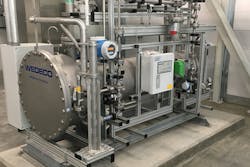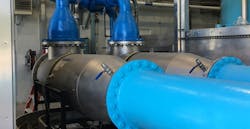Groundwater Replenished to Prevent Sea Level Rise
Groundwater in southeastern coastal Virginia is depleting due to over-drafting without intentional replenishment. This phenomenon makes the Potomac aquifer susceptible to saltwater intrusion and land subsidence, the gradual settling or sudden sinking of the earth’s surface. The Hampton Roads Sanitation District (HRSD) regional wastewater utility services 18 Virginia counties with a total population of 1.7 million using 13 treatment plants to provide a combined capacity of 249 million gal per day (mgd). Responsibility for the area’s saltwater intrusion and land subsidence problems fell squarely onto HRSD.
Scope
HRSD responded to these issues by using groundwater augmentation as a way to recharge the aquifer, prevent saltwater intrusion and potentially increase ground elevation. In 2016, HRSD began piloting different treatment schemes and strategies for its newly formed Sustainable Water Initiative for Tomorrow (SWIFT) program.
After piloting was complete, HRSD built the SWIFT Research Center in Suffolk, Va., which includes a 1-mgd advanced water treatment facility and recharge well, treatment facilities to support ongoing research, and space for hosting and educating the public. The primary goal of the SWIFT project is to meaningfully demonstrate how advanced treatment can produce water that meets potable reuse standards and is compatible with the receiving aquifer.
The SWIFT Research Center is not the only beneficiary of reuse water for aquifer replenishment. Additionally, the groundwater augmentation efforts:
- Sustainably recharge groundwater supplies;
- Reduce harmful nutrients discharged into Chesapeake Bay;
- Support economic development;
- Mitigate land subsidence;
- Block saltwater intrusion;
- Increase available oyster grounds; and
- Provide drought resilience for more than 25% of all Virginians.
The research center was completed in winter 2018, but HRSD began recharging the aquifer in May 2017 to demonstrate its confidence in the water’s compatibility with the aquifer.
Solution
HRSD implemented a rigorous piloting regime prior to the installation of the SWIFT Research Center. The pilot compared two different treatment trains—the first was an ozone and biologically active filtration (BAF) based treatment train, and the second was a reverse osmosis (RO)-based treatment train. The two treatment trains provided strong performance for pathogen removal, as well as for the reduction of total organic carbon (TOC) and contaminants of emerging concern (CEC). The ozone-BAF treatment process was deemed more beneficial because a harmful brine discharge was part of the RO treatment process. In addition, the ozone-BAF process produced water that was more compatible with the aquifer—an important requirement of this program.
Based on the positive pilot results and the overall improved health of the watershed, the next step was to implement a full-scale 1-mgd ozone-BAF advanced water treatment facility. Xylem supplied HRSD with its Oxelia ozone-BAF system, consisting of two SMOevo 610 ozone generators along with four BAF filter cells, a pair of Spektron 2000e ultraviolet (UV) reactors and two YSI/WTW TresCon continuous monitors for ammonia, nitrate and nitrite.
Ozone generator installation is simple, and the electrode technology is virtually maintenance-free. The UV reactors feature high-efficiency UV lamp and ballast technology, an operator-friendly system controller with SCADA communication, and a chemical-free, automatic mechanical wiping system that will provide HRSD with potent virus inactivation. Additionally, seamless online access that enables the variation of process control to generate useful research for the water reuse industry is an important factor in the operation of the Oxelia ozone-BAF and UV systems.
Result
The facility now recharges the aquifer at a rate of 1 mgd, which is expected to rise to 100 mgd by 2030. HRSD also is planning to use treated water as part of its groundwater augmentation strategy at seven of its 13 wastewater treatment plants within the next year.
In July 2018, the SWIFT project was named the public sector winner of the US Water Alliance’s 2018 US Water Prize. According to the Alliance, the project is an “outstanding achievement in the advancement of sustainable, integrated and inclusive solutions to our nation’s water challenges.”


